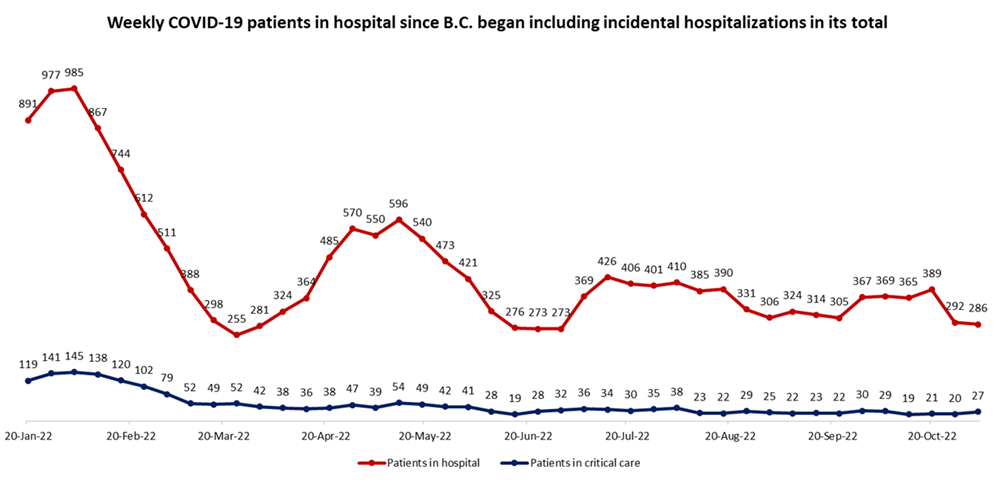B.C.'s hospitalized COVID-19 population continues unexpected decline
 Courtesy: Shutterstock.
Courtesy: Shutterstock.
The surprising downward trend in B.C.'s hospitalized COVID-19 population continued this week, with the number of test-positive patients in hospital dropping to 286.
This week's data from the B.C. Centre for Disease Control also included a decreasing number of newly confirmed infections and new admissions to hospital, though, as always, the data comes with many caveats.
 This graph shows the number of people in hospital with COVID-19 on Thursdays since B.C. switched to a "hospital census" model in January. (CTV)
This graph shows the number of people in hospital with COVID-19 on Thursdays since B.C. switched to a "hospital census" model in January. (CTV)
The current hospital population includes every patient who tests positive for COVID-19, regardless of whether the disease is the underlying reason for their hospitalization.
Provincial health officials have previously said between 40 and 50 per cent of hospitalizations included in the weekly total are caused by COVID-19, while the rest are incidental cases.
Since the province switched to this "hospital census" method of counting hospitalizations in January, there have been as many as 985 test-positive patients in B.C. hospitals on a Thursday, and as few as 255.
FALL SURGE?
The recent decline in B.C.'s hospitalized population comes after weeks of warnings from health officials that a fall surge was on the way.
Despite indications in September that such a surge might be beginning, more recent data has suggested things are trending in the opposite direction.
Not only has the number of people currently in hospital declined to its lowest point since June, but the number of new admissions to hospital – a separate measurement – has also been trending downward.
Last week, the BCCDC announced 148 new hospital admissions for the epidemiological week ending Oct. 22. That figure has been revised up to 180 in this week's update, but remains below the revised figures for previous weeks, which were over 200.
Similarly, this week's total for the week that ended Oct. 29 was 116 new admissions, a lower starting point than the previous week's.
In its "key messages" for this week's update, the BCCDC notes that test positive cases have been declining in recent weeks, and "trends in severe outcomes (new hospital admissions, new critical care admissions, and deaths) are relatively stable or declining overall."
The number of new lab-confirmed cases for the week ending Oct. 29 was 486, the lowest weekly total B.C. has seen since it switched to weekly reporting of COVID-19 data.
While B.C.'s limited testing strategy means this number is not remotely reflective of the total number of new infections being seen in the province, the fact that it has continued to decline is notable.
Last week, when asked by CTV News if there had been a decrease in testing or some other change to COVID-19 data collection and reporting that could explain the declines in hospital population and official case counts, the BCCDC said "there is no indication that there are any new issues with the data."
The most recent report from the independent B.C. COVID-19 Modelling Group offers a plausible explanation for the apparent lull in coronavirus activity in the province.
"In late 2022, most individuals have been exposed to the virus, either by infection, vaccination, or both," the report reads.
"With few individuals currently susceptible, new infections substantially reduce the remaining susceptible fraction, causing the growth rate, r, to decline from day to day. An increase in transmission rate (e.g., due to closer or more frequent contacts) can shift r to be positive again, but r will decrease each day following that change due to new infections."
The report goes on to explain that waning immunity will lead to an increase in transmission, but notes that growth of the virus in the population "will reverse once the immunity lost through waning is offset by new immunity, gained by vaccination and/or new infections."
Sarah Otto, a member of the modelling group and a professor of biomathematics at the University of British Columbia, told CTV News last week that she's cautiously optimistic B.C. is headed for a period of ongoing infections due to waning immunity, but will avoid a massive new wave of cases this fall.
VACCINATION DATA
To combat waning immunity and thwart the possibility of a surge in infections, the province has been encouraging people to get booster doses of bivalent COVID-19 vaccines.
During the week that ended Oct. 29, a total of 176,215 people received a COVID-19 vaccine. That's the largest weekly total since the fall booster campaign began, though it's less than 1,000 more shots than the province administered during the previous week.
Of the doses administered during the week, the majority – 96,295 doses or roughly 55 per cent of the total – were considered "fourth doses," according to the BCCDC's COVID-19 dashboard.
Another 10,383 doses, about six per cent of the total, were third doses.
The province also administered 3,538 second doses (two per cent) and 2,374 first doses (one per cent).
The remaining 63,625 shots (36 per cent of the total) administered during the week went to people who had already had at least four doses of COVID-19 vaccine.
CTVNews.ca Top Stories

Prime Minister Trudeau meets Donald Trump at Mar-a-Lago
Prime Minister Justin Trudeau landed in West Palm Beach, Fla., on Friday evening to meet with U.S.-president elect Donald Trump at Mar-a-Lago, sources confirm to CTV News.
'Mayday! Mayday! Mayday!': Details emerge in Boeing 737 incident at Montreal airport
New details suggest that there were communication issues between the pilots of a charter flight and the control tower at Montreal's Mirabel airport when a Boeing 737 made an emergency landing on Wednesday.
Hit man offered $100,000 to kill Montreal crime reporter covering his trial
Political leaders and press freedom groups on Friday were left shell-shocked after Montreal news outlet La Presse revealed that a hit man had offered $100,000 to have one of its crime reporters assassinated.
Questrade lays off undisclosed number of employees
Questrade Financial Group Inc. says it has laid off an undisclosed number of employees to better fit its business strategy.
Cucumbers sold in Ontario, other provinces recalled over possible salmonella contamination
A U.S. company is recalling cucumbers sold in Ontario and other Canadian provinces due to possible salmonella contamination.
Billboard apologizes to Taylor Swift for video snafu
Billboard put together a video of some of Swift's achievements and used a clip from Kanye West's music video for the song 'Famous.'
Musk joins Trump and family for Thanksgiving at Mar-a-Lago
Elon Musk had a seat at the family table for Thanksgiving dinner at Mar-a-Lago, joining President-elect Donald Trump, Melania Trump and their 18-year-old son.
John Herdman resigns as head coach of Toronto FC
John Herdman, embroiled in the drone-spying scandal that has dogged Canada Soccer, has resigned as coach of Toronto FC.
Weekend weather: Parts of Canada could see up to 50 centimetres of snow, wind chills of -40
Winter is less than a month away, but parts of Canada are already projected to see winter-like weather.

































